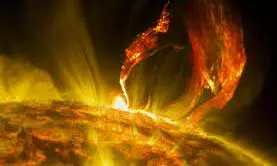
Sun releases 2 powerful solar storms while approaching peak activity
text_fieldsNew York: The Sun is approaching the peak of its activity during the current solar cycle releasing many flares capable of affecting the normal life on Earth, NDTV reported citing sources.
During the solar cycle of 11-year period the star’s magnetic field goes through a cycle switching its north and south poles.
It takes about another 11 years for the Sun's north and south poles to flip back again.
Suggesting the intense activity, two huge solar flares erupted from sunspot region AR3663 towards Earth.
The first flare occurred on May 2 was an X-class flare meaning it is of the most powerful category, the report said citing Space.com.
This led to shortwave radio blackouts across Australia, Japan and much of China, as per the report.
"X FLARE! Sunspot region AR3663 just produced an X1.7 flare, the 11th largest flare so far this cycle. It was an impulsive flare lasting a total of about 25 minutes and peaking at 02:22 U.T," solar physicist Keith Strong reportedly wrote on X.
The second eruption on May 3 was an M-class flare, it was reported.
There were a number of flares erupting from the newly emerged spot on the surface of the sun.
During the both eruptions, the sunspot was facing Earth. Alongside, one of these flares could have followed what the report said a coronal mass ejection (CME), which is large expulsion of plasma and magnetic field, according to the report.
The CME directed towards the Earth can damage power grids, telecommunication networks and orbiting satellites, alongside exposing astronauts to dangerous doses of radiation.
Solar flares occur, according to NASA, when magnetic fields in and around the Sun reconnect. It takes places once magnetic energy builds up in the solar atmosphere and is released.























